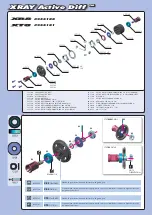
31
11 EPA setting for steering and drive (4 small dials)
Control dials "EPA-ST (Left)" and "EPA-ST (Right)":
With these two dials, you can limit the steering travel to
the left and the right. The adjustment can be made independently for both sides. Whether the setting applies to the
left or the right depends of course on the setting of the reverse switch (3) and may therefore be swapped on this
vehicle.
Setting the maximum steering angle is intended to prevent overloading of the steering servo when the steering
mechanism has already reached the end position. A greater movement of the steering servo does not cause
additional movement of the steering mechanism in this case, it just overstrains the servo drive and uses a lot of
power.
Control dials "EPA-TH (Backward)" and "EPA-TH (Forward)":
With these two dials, you set the maximum
speed for forward and reverse driving. Normally both dials should be turned all the way to the right (clockwise) to
"MAX". However, for beginners it makes sense to limit the speed.
The reverse switch (4) determines whether the settings are made for forward or reverse movement. The settings
can therefore be inverted.
12 Dual rate control for steering
With the dual rate control, you limit the possible steering angle when turning the steering dial (8). This way, you can
steer the vehicle more accurately e.g. at high speeds.
Control turned to the right = large steering angle when steering dial (8) is fully turned
Control turned to the left = small steering angle when steering dial (8) is fully turned
13 Lever for forward/reverse driving
With this lever, you control the drive and the brake functions of the vehicle. See chapter 9. j) in these operating
instructions.
14 Battery compartment
Insert 8 type AA/mignon batteries here or 8 rechargeable batteries (observe the correct polarity). The correct
polarity is indicated in the battery compartment.
15 Charging jack
If rechargeable batteries are inserted in the transmitter, these can be charged using a suitable charging cable and
charger.
The charging current must not exceed 250mA, otherwise the circuitry in the transmitter may become damaged. Do
not connect any quick chargers! Observe the correct polarity (inner wire is positive "+", see the label next to the
charging jack if reqd.)
Never recharge conventional, non-rechargeable batteries! There is a risk of fire and explosion! Only charge
rechargeable batteries meant for this purpose (NiCd/NiMH).
















































